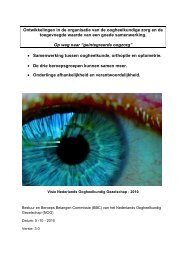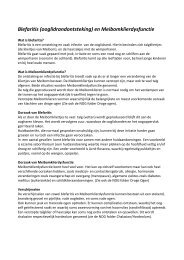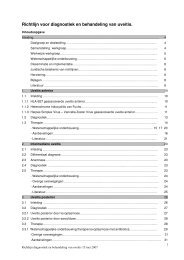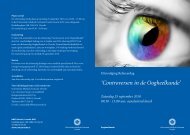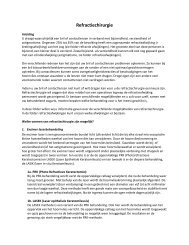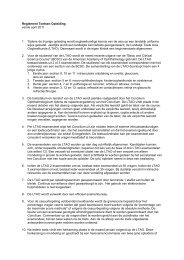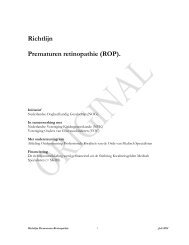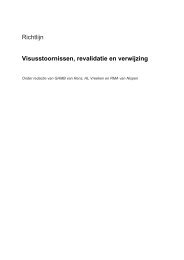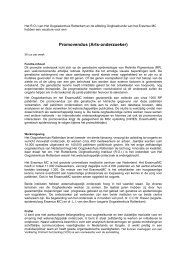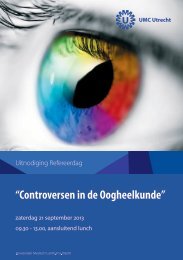terminology and guidelines for glaucoma ii - Kwaliteitskoepel
terminology and guidelines for glaucoma ii - Kwaliteitskoepel
terminology and guidelines for glaucoma ii - Kwaliteitskoepel
You also want an ePaper? Increase the reach of your titles
YUMPU automatically turns print PDFs into web optimized ePapers that Google loves.
1.4 - VISUAL FIELD<br />
The field of vision is defined as the area that is perceived when both eyes are open. Clinically, each eye is assessed independently.<br />
Please see FC II, III, IV.<br />
There are two main methods of testing the visual field (VF):<br />
A) Kinetic perimetry: a stimulus is moved from a nonseeing area of the visual field to a seeing area along a set meridian.<br />
The procedure is repeated with the same stimulus along other meridians, usually spaced every 15°. The luminance<br />
<strong>and</strong> size of the target is changed in order to plot areas of different light sensitivity.<br />
B) Static perimetry: the size <strong>and</strong> location of the test target remain constant. The retinal sensitivity or threshold at a specific<br />
location is determined by varying the brightness of the test target. The shape of the hill of vision is defined by<br />
repeating the threshold measurement at various locations in the field of vision.<br />
In this chapter we refer mainly to Humphrey <strong>and</strong> Octopus perimeters, which are the most popular in Europe; several<br />
other br<strong>and</strong>s offer similar examination capabilities.<br />
1.4.1 - APOSTILBS & DECIBELS<br />
In perimetry the luminance of the test target is measured in Apostilbs (asb).<br />
1 asb = 0.3183 c<strong>and</strong>ela/m2 = 0.1 millilambert<br />
The decibel scale is a relative scale created by the manufacturers of automated perimeters to measure the sensitivity<br />
each tested point of the hill of vision. It is an inverted logarithmic scale. Zero decibels is set as the brightest stimulus<br />
Apostilbs Humphrey Decibels Octopus Decibels<br />
0.1 50 40<br />
1 40 30<br />
1000 10 0<br />
10000 0 -<br />
1 bel = 1 log Unit = tenfold change in intensity<br />
1 decibel = 0.1 log Unit<br />
Decibel = dB<br />
that each perimeter can produce. The decibel scale is not st<strong>and</strong>ardised because the maximal luminance of the stimulus<br />
varies between instruments.<br />
It is important to note that:<br />
1) “0” dB do not correspond to the same stimulus luminance <strong>for</strong> Humphrey <strong>and</strong> Octopus<br />
2) “0” dB does not mean a blind area but rather an area where the sensitivity of the retina to the stimulus is below the<br />
maximum brightness <strong>for</strong> a given perimeter.<br />
1.4.2 - STATIC VISUAL FIELD EXAM<br />
1.4.2.1 - Reference tests <strong>for</strong> <strong>glaucoma</strong><br />
1.4.2.1.1 - Conventional techniques<br />
Humphrey Perimeter, programs 24-2 or 30-2, or Octopus 32 measure the retinal sensitivity at 54 or 76 points in the<br />
Ch. 1 - 24 EGS



